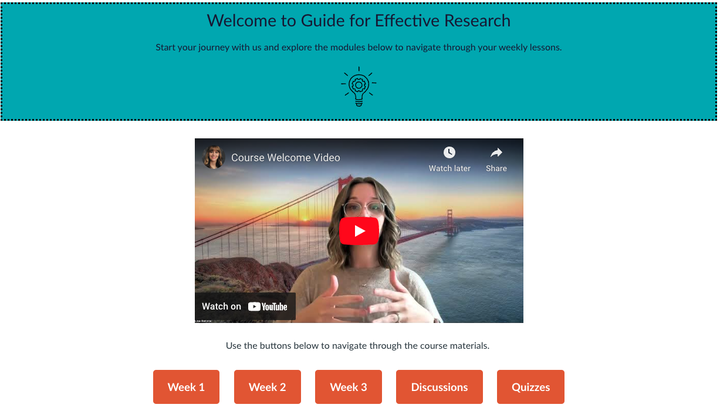Guide for Effective Research
 Image by L. Batista
Image by L. Batista
Abstract
“Guide for Effective Research” is an online training course hosted through Canvas. This collection of self-paced, asynchronous training modules provide basic research skills and curated resources and can be implemented as a stand alone learning opportunity or as supplementary material within a longer learning experience.
Responsibilities: instructional design (action mapping, storyboarding, mockups, prototype, user testing, full development), visual design, eLearning development
Audience: Adult and young adult learners
Learning theories: Cognitivism, constructivism, adult learning theories, Bloom’s Taxonomy
Tools used: Adobe Captivate, Canvas, Scorm Cloud, Google Docs, Miro
To check out and enroll in the course, see “Guide for Effective Research”.
The Problem and Solution
Basic research skills are essential for everyone in today’s information-rich world. Whether you are a high school student, a professional in the workplace, or simply someone striving to navigate the internet more intentionally, this course equips learners with simple, actionable steps to research more efficiently and effectively.
By mastering these skills, participants can better address the challenges of fake news and misinformation while gaining greater autonomy in navigating an increasingly complex online environment.
This self-paced online course is structured into multiple topic-focused modules, providing learners with the tools to learn, practice, and evaluate foundational research techniques. Each module includes comprehensive learning guides, supplementary resources, and opportunities to engage with a supportive instructor, ensuring an interactive and enriching learning experience.

My Process
To design this course, I utilized the SAM (Successive Approximation Model) framework in combination with Backward Design. I began by gathering information about the target audience to identify potential knowledge gaps. Drawing from my background in education and experience in instructional design, I aimed to create a course that bridges the needs of high school students, professionals, and adult learners by focusing on universally applicable research skills.
After defining the audience and focus areas, I employed backward planning to outline key objectives. The course is designed to help learners critically evaluate sources for trustworthiness and bias, answer research questions effectively, and use search engines strategically. These objectives guided the development of the first three modules of the course (source evaluation, search engine basics, and fact checking).

Each module followed, or is currently following, the iterative design, prototype, and review phases of the SAM model. I incorporated storyboarding and action mapping to ensure a logical and engaging progression of content. Assessments were crafted to measure learners’ progress and provide meaningful feedback. Once the modules were fully planned, I worked through course design basics, including becoming proficient with Canvas as an administrator, to ensure a smooth and accessible learning experience.

Favorite Features
ABCD Evaluation Module

Using Adobe Captivate, I designed a fully asynchronous eLearning module that incorporates frequent knowledge checks. These checks provide immediate feedback, fostering active engagement and reinforcing learning outcomes. To support diverse learning preferences, the module is paired with a notetaking guide included in the Week 1 materials, offering additional structure for users who benefit from guided learning tools.

Assessment pieces
To ensure learning, gauge progress, and provide feedback, I develop several assessments throughout the three modules. Many are formative knowledge checks as shown in the evaluation module and the Fact Checking scenario-based training, and some are more summative. One such summative assessment is a multiple choice quiz that challenges learners to think at a deeper, more authentic level and better meets the learning objectives.
Overall Course Design
I developed the course design by adhering to a consistent visual style, using ADA-compliant colors and fonts to ensure accessibility and a pleasing user experience. To maintain uniformity across the course, I utilized basic HTML and incorporated creative, visually engaging elements such as custom homepage buttons and a welcome video.
Recognizing the importance of fostering a sense of connection in an asynchronous, self-paced course, I included a discussion board to encourage peer interaction and teacher welcome videos for each module to introduce a more personal, human element to the learning experience.
